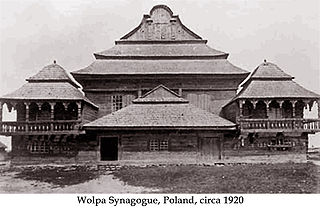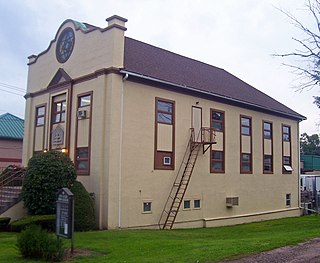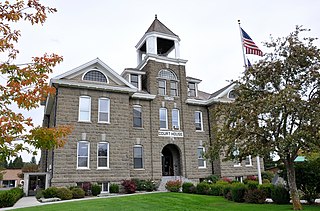The Signora Giveret Synagogue (Turkish : Sinyora giveret sinagogu) is an Orthodox Jewish synagogue in the city of Izmir, Turkey. The synagogue dates back to the 16th century and is still in use today.
Contents



The Signora Giveret Synagogue (Turkish : Sinyora giveret sinagogu) is an Orthodox Jewish synagogue in the city of Izmir, Turkey. The synagogue dates back to the 16th century and is still in use today.



Signora Giveret Synagogue was built by a Portuguese merchant in 16th century. [1] It stands at the junction of 927 Street (known as Havra Sokak (‘Synagogue Street’)) with Anafartalar Avenue. [2] The building was damaged in the major fire of 1841, and subsequently restored by the Yeruşalmi family according to the original design. The new construction also used Italian architecture style.
Signora Giveret Synagogue has a big yard surrounded by massive, high walls that block the view from the outside. [1] There are add-on structures in the yard that are referred to as Bet Midaş. Şalom and Algaze Synagogues, on Havra street, are neighboring buildings. The synagogue is located in Kemeraltı, a historic bazaar of İzmir, forming a network of small shops, stores and narrow streets which surround the synagogue. [3] [4]
Congregants access a terrace via a 5 step stairway. The portable spruce wall of the synagogue merges with the torah ark. Seats are arranged linearly, similar to church interiors. The mechitza starts in the entrance hall open to the main interior. This space adjoins the hekal wall as a mezzanine which is separated by wooden latices. The structure is a double standard construction space and is seen as a single volume. It was constructed using stone masonry. The building has a wooden hip roof. The floor and ceiling are also wooden. The building entrance is a simple iron door. From the entrance one can see across the north facade of the building, which also has a simple view. Through a short hallway one can reach the yard and the entrance of the building. The building has modest furniture and many windows for natural light. Seats are arranged carefully and owners' names are carved on some of them. Some wooden seats are located on the sides, next to the walls.
The building is made of stone and brick and has a rectangular floor plan. It is covered by a wooden hipped roof. One can reach the mechitza, which is on top of entering hall, through the yard. This space was placed against the hekal wall as a mezzanine which separated by wooden latices. In floor and ceiling contain tiles and wood. The inside contains bronze flowers surrounded by green geometric forms on the ceiling, spruce torah cabinet and bordeaux coverings. Since the building is masonry work, the window openings are arched. The windows in north and south facade give the building natural light. [5]
{{cite web}}: CS1 maint: postscript (link)
A mechitza in Judaism, is a partition, particularly one that is used to separate men and women.

Konak is a district of İzmir Province in Turkey. It is the most densely populated of the eleven main urban districts of İzmir, and has historically acted as the administrative and economic core of the city. Situated in an area that roughly corresponds to the geographic center of İzmir, Konak extends for 11.4 kilometres along the southern coastline of the Gulf of İzmir. A long panhandle that the district area draws in the direction of the southwest, on the other hand, also covers a large rural area, mostly covered with mountains and forests, and two isolated villages. Konak district area neighbors the district areas of Bornova to the east, Balçova to the west and Buca and Gaziemir to the south, all of which are also among İzmir's metropolitan districts. Konak center is connected to other districts of İzmir and beyond by a dense network of roads and railroads, as well as by a subway line currently being largely extended and by ferry services to Karşıyaka. Konak is a very active hub of industry, trade, commerce and services, with the number of companies exceeding sixty thousand and its exports nearing two billion US Dollars in 2006.

The Four Sephardic Synagogues are located in the Jewish Quarter of the Old City of Jerusalem. They form a complex of four adjoining synagogues. The first three synagogues were built at different periods to accommodate the religious needs of the Sephardic community, each congregation practising a different rite; later the courtyard was converted into what became known as the "middle synagogue".

Karataş is a neighborhood of İzmir, Turkey, within the boundaries of the city's central metropolitan district of Konak. The neighborhood no longer has an official delimitation or status and exists as a notional zone (semt) that is admitted to stretch along the small cove of the same name in the Gulf of İzmir. Its area roughly corresponds to the officially delimited quarter (mahalle) named Turgut Reis. The inhabitants, among whom neighborhood pride is quite developed, also usually declare living in Karataş

The Remah Synagogue is a 16th-century Jewish temple and the smallest of all historic synagogues in the Kazimierz district of Kraków, Poland. The synagogue is named after Rabbi Moses Isserles (c.1525–1572), known by the Hebrew acronym ReMA who's famed for writing a collection of commentaries and additions that complement Rabbi Yosef Karo's Shulchan Aruch, with Ashkenazi traditions and customs. It is currently one of two active synagogues in the city.

Kemeraltı is a historical market (bazaar) district of İzmir, Turkey. It remains one of the liveliest parts of İzmir.

The Ibn Danan Synagogue is a synagogue in Fes, Morocco, dating from the 17th century. It was built by Mimoun Ben Sidan, a wealthy merchant from the town of Ait Ishaq. The synagogue is located in the Mellah district within Fes el-Jdid, one of the components of the historic medina of Fes.

The Grand synagogue of Aden, also known as Shield of Avraham Synagogue or "Magen Avraham", was built in 1858. The synagogue was founded in 1860 by Menahem Messa. It was large enough to house over 2,000 worshipers. The pulpit was made of marble – pure, white and polished, with 7 marble steps leading up to it. The floor was made of marble sections, patterned black and white as on a chess board. The ark was built into the wall pile or stack, and covered by six curtains woven with silk and interwoven with gleaming sapphires, above them the crowns of the torah. The torah scrolls were adorned with crowns and pomegranates, some of them gold, and some of them pure refined silver. The two tablets of the 10 commandments on both sides of the doors were made of polished silver. The huge ceiling was supported by eight wooden columns, four on each side. Each column had a radius of 80 inches and were 40 feet high. The ceiling and the numerous windows are replete with stained glass in blazing colour and dozens of lanterns. Along the Eastern wall was a women’s section with 200 places. The entrance to the synagogue was through a huge courtyard which also served as a place of worship on Sabbath and the high holy days. A mikvah was also built on the southern side of the synagogue.

The Włodawa Synagogue in Włodawa, Poland is an architectural complex consisting of two historic synagogues and a Jewish administrative building, now preserved as a museum. The complex includes the Włodawa Great Synagogue of 1764–74, the late 18th century Small Synagogue, and the 1928 community building. It is "one of the best-preserved" synagogues in Poland.

Córdoba Synagogue is a historic edifice in the Jewish Quarter of Córdoba, Spain, built in 1315. The synagogue's small size points to it having possibly been the private synagogue of a wealthy man. It is also possible that Córdoba's complex of buildings was a yeshivah, kollel, or study hall. Another possibility is that this was the synagogue of a trade guild, which converted a residence or one of the work rooms into the synagogue. The synagogue was decorated according to the best Mudejar tradition.

The Przedbórz Synagogue was a wooden synagogue in Przedbórz, Poland.

The Wołpa Synagogue was a synagogue located in the town of Voŭpa, in what is now western Belarus. It was reputed to be the "most beautiful" of the wooden synagogues of the former Polish–Lithuanian Commonwealth, a "masterwork" of wooden vernacular architecture.

Ohave Shalom Synagogue is located on Maurice Rose Street in Woodridge, New York, United States. It is a brick building erected in 1930 by a splinter group from what was then the village's only synagogue, later absorbed into Ohave Shalom itself.

The South Fallsburg Hebrew Association Synagogue is located on Lake Street in the hamlet of South Fallsburg, New York, United States. Built in 1902, it underwent a major expansion in 1919 that included being raised a story.

The New Synagogue in Ostrów Wielkopolski, Poland, is located in the city's center on 21 Raszkowska Street, which was the northern edge of the former Jewish district. Currently, this is the only preserved metropolitan synagogue. It is built in the once very popular Moorish Revival style. It is the most precious monument of religious architecture in Ostrów Wielkopolski. Long neglected, the synagogue has been fully restored in 2010. See the municipal website for updates:

Congregation Bnai Israel Synagogue is located on Wagner Avenue in Fleischmanns, New York, United States. It is a wooden building dating to the *1920s, built two years after local farmers founded the congregation. Originally an Orthodox synagogue, it has since become Conservative. It is the only synagogue in the Catskills with an exposed truss roof. In 2002, the synagogue was added to the National Register of Historic Places, after a multi-year effort by Bernard Rosenberg, the descendant of a founding member. Congregation Bnai Israel Synagogue is the only synagogue in Delaware County to be listed.

The Wallowa County Courthouse is the seat of government for Wallowa County in northeastern Oregon. The courthouse is located in Enterprise, Oregon. It was built in 1909–1910 using locally quarried stone. It is a massive High Victorian structure built of local Bowlby stone. The courthouse was listed on National Register of Historic Places in 2000. Today, the courthouse still houses Wallowa County government offices.

The Or Zaruaa Synagogue, Nachlaot, Jerusalem- Hebrew: בית כנסת אור זרוע, נחלאות, ירושלים was founded in 1926 by Rabbi Amram Aburbeh for the Ma’araviim Jewish congregation in Jerusalem. It is located on 3 Shmuel Refaeli Street in the Nachalat Ahim neighbourhood in Jerusalem.

Grahame's Corner is a heritage-listed commercial and office building located at 142-144 Pitt Street, in the Sydney central business district, in the City of Sydney local government area of New South Wales, Australia. It was designed by G. A. Morell and built from 1877 to 1882. It is also known as Grahams Corner and the AMFIS Building. The property was added to the New South Wales State Heritage Register on 2 April 1999.

The Synagogue of Alanta is a former synagogue in Alanta, Molėtai District Municipality, Lithuania.